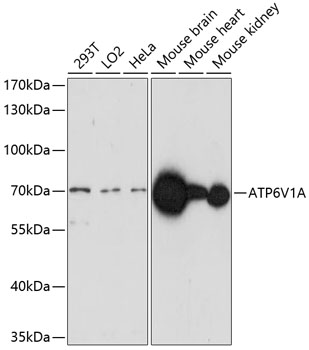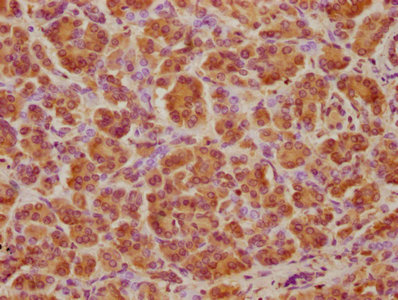ATP6V1A antibody
GTX110815
ApplicationsImmunoPrecipitation, Western Blot, ImmunoHistoChemistry, ImmunoHistoChemistry Paraffin
Product group Antibodies
ReactivityHuman, Mouse
TargetATP6V1A
Overview
- SupplierGeneTex
- Product NameATP6V1A antibody
- Delivery Days Customer9
- Application Supplier NoteWB: 1:1000-1:10000. IHC-P: 1:100-1:1000. IP: 1:100-1:500. *Optimal dilutions/concentrations should be determined by the researcher.Not tested in other applications.
- ApplicationsImmunoPrecipitation, Western Blot, ImmunoHistoChemistry, ImmunoHistoChemistry Paraffin
- CertificationResearch Use Only
- ClonalityPolyclonal
- Concentration0.57 mg/ml
- ConjugateUnconjugated
- Gene ID523
- Target nameATP6V1A
- Target descriptionATPase H+ transporting V1 subunit A
- Target synonymsARCL2D, ATP6A1, ATP6V1A1, DEE93, HO68, IECEE3, VA68, VPP2, Vma1, V-type proton ATPase catalytic subunit A, ATPase, H+ transporting, lysosomal 70kDa, V1 subunit A, ATPase, H+ transporting, lysosomal, subunit A1, H(+)-transporting two-sector ATPase, subunit A, H+-transporting ATPase chain A, vacuolar (VA68 type), V-ATPase 69 kDa subunit 1, V-ATPase A subunit 1, V-ATPase subunit A, V-type proton ATPase (V-ATPase) catalytic subunit A, vacuolar proton pump alpha subunit 1, vacuolar proton pump subunit alpha, vacuolar-type H(+)-ATPase
- HostRabbit
- IsotypeIgG
- Protein IDP38606
- Protein NameV-type proton ATPase catalytic subunit A
- Scientific DescriptionThis gene encodes a component of vacuolar ATPase (V-ATPase), a multisubunit enzyme that mediates acidification of eukaryotic intracellular organelles. V-ATPase dependent organelle acidification is necessary for such intracellular processes as protein sorting, zymogen activation, receptor-mediated endocytosis, and synaptic vesicle proton gradient generation. V-ATPase is composed of a cytosolic V1 domain and a transmembrane V0 domain. The V1 domain consists of three A and three B subunits, two G subunits plus the C, D, E, F, and H subunits. The V1 domain contains the ATP catalytic site. The V0 domain consists of five different subunits: a, c, c, c, and d. Additional isoforms of many of the V1 and V0 subunit proteins are encoded by multiple genes or alternatively spliced transcript variants. This encoded protein is one of two V1 domain A subunit isoforms and is found in all tissues. Transcript variants derived from alternative polyadenylation exist. [provided by RefSeq]
- ReactivityHuman, Mouse
- Storage Instruction-20°C or -80°C,2°C to 8°C
- UNSPSC12352203
References
- Lee JH, Yang DS, Goulbourne CN, et al. Faulty autolysosome acidification in Alzheimer's disease mouse models induces autophagic build-up of Aβ in neurons, yielding senile plaques. Nat Neurosci. 2022,25(6):688-701. doi: 10.1038/s41593-022-01084-8Read this paper
- Perez-Canamas A, Takahashi H, Lindborg JA, et al. Fronto-temporal dementia risk gene TMEM106B has opposing effects in different lysosomal storage disorders. Brain Commun. 2021,3(1):fcaa200. doi: 10.1093/braincomms/fcaa200Read this paper
- Yoon SJ, Jo DH, Park SH, et al. Thioredoxin-Interacting Protein Promotes Phagosomal Acidification Upon Exposure to Escherichia coli Through Inflammasome-Mediated Caspase-1 Activation in Macrophages. Front Immunol. 2019,10:2636. doi: 10.3389/fimmu.2019.02636Read this paper
- Zirngibl RA, Wang A, Yao Y, et al. Novel c.G630A TCIRG1 mutation causes aberrant splicing resulting in an unusually mild form of autosomal recessive osteopetrosis. J Cell Biochem. 2019,120(10):17180-17193. doi: 10.1002/jcb.28979Read this paper
- Hashimoto Y, Shirane M, Nakayama KI. TMEM55B contributes to lysosomal homeostasis and amino acid-induced mTORC1 activation. Genes Cells. 2018,23(6):418-434. doi: 10.1111/gtc.12583Read this paper
- Deng Y, Qin Y, Srikantan S, et al. The TMEM127 human tumor suppressor is a component of the mTORC1 lysosomal nutrient-sensing complex. Hum Mol Genet. 2018,27(10):1794-1808. doi: 10.1093/hmg/ddy095Read this paper
- Wang A, Carraro-Lacroix LR, Owen C, et al. Activity-independent targeting of mTOR to lysosomes in primary osteoclasts. Sci Rep. 2017,7(1):3005. doi: 10.1038/s41598-017-03494-2Read this paper
- Matsumoto A, Pasut A, Matsumoto M, et al. mTORC1 and muscle regeneration are regulated by the LINC00961-encoded SPAR polypeptide. Nature. 2017,541(7636):228-232. doi: 10.1038/nature21034Read this paper
- Henderson MX, Wirak GS, Zhang YQ, et al. Neuronal ceroid lipofuscinosis with DNAJC5/CSPα mutation has PPT1 pathology and exhibit aberrant protein palmitoylation. Acta Neuropathol. 2016,131(4):621-37. doi: 10.1007/s00401-015-1512-2Read this paper
- Jewell JL, Kim YC, Russell RC, et al. Metabolism. Differential regulation of mTORC1 by leucine and glutamine. Science. 2015,347(6218):194-8. doi: 10.1126/science.1259472Read this paper




